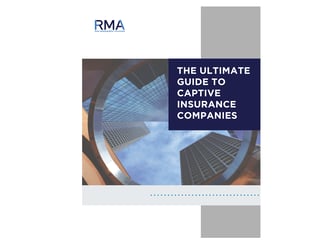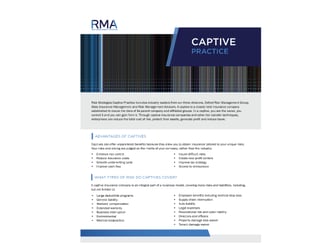Once a captive insurance company is formed and licensed, the captive insurance owner must now turn its attention to actually running the captive insurance company. The first step in the process is to learn the responsibilities of each captive insurance management function. In order to delegate the responsibilities you must know what they are. Second, no matter what partners are retained to provide management support, you are still ultimately responsible for the regulatory compliance of the captive insurance company. So, to repeat, it is very important for you to spend the time it takes to clearly understand the regulatory and fiduciary requirements of managing a captive insurance company.
Key Components Of Captive Management
At its highest level, captive insurance management focuses on five key areas:
- Financial Management
- Claims Management
- Compliance and Regulatory Reporting
- Risk Monitoring and Oversight
- Investment Management
There are certainly more functions of a captive insurance company (e.g., strategic planning, risk management, marketing, communication, etc.), but these five are important to understand upfront. Each requires specific expertise and industry knowledge.
Financial Management
Managing a captive insurance company involves various tasks, including premium collection and accounting. These processes are crucial for the financial stability and success of the company. Here are some key aspects involved in the management of premium collection and accounting for a captive insurance company.
- Premium Calculation
- Premium Collection
- Payment Process
- Maintaining Accurate Financial Records
Here's a table summarizing the key aspects of premium collection and accounting in captive insurance management:
|
Aspect |
Premium Collection and Accounting |
|
Premium Calculation Methods |
Historical loss experience, industry benchmarks, actuarial analysis |
|
Premium Collection and Payment Process |
Timely and accurate collection of premiums from policyholders |
|
Maintaining Accurate Financial Records |
Proper accounting and record-keeping for monitoring performance |
These processes play a vital role in the effective management of a captive insurance company, ensuring its financial stability and success.
Claims Management
Managing claims is a critical aspect of running a captive insurance company. It involves handling and resolving insurance claims submitted by policyholders. Effectively managing claims ensures that policyholders receive the necessary support and compensation in a timely manner. Here are the key components involved in the management of a captive insurance company's claims process.
- Establishing a Claims Handling Process
- Investigating and Evaluating Claims
- Resolving Claims Efficiently
Here's a table summarizing the key components of claims management in a captive insurance company:
|
Component |
Description |
|
Claims Handling Process |
Establishing a clear and well-defined process |
|
Investigation and Evaluation |
Thoroughly assessing the validity and coverage of claims |
|
Resolving Claims Efficiently |
Promptly communicating and making fair settlement decisions |
Effective claims management is crucial for the success of a captive insurance company. By establishing a robust claims handling process, conducting thorough investigations, and resolving claims efficiently, the company can effectively fulfill its obligations to policyholders and maintain financial stability.
Compliance and Regulatory Reporting
Managing a captive insurance company involves a range of responsibilities, including ensuring compliance with various local and international regulations. Captive insurance companies are subject to regulatory guidelines and must adhere to specific legal requirements to operate effectively. Here are the key components involved in the compliance and regulatory reporting of a captive insurance company:
- Complying with Local and International Regulations
- Preparing and Submitting Required Reports
- Managing Compliance Audits
Managing the compliance and regulatory reporting aspects of a captive insurance company requires expertise and attention to detail. Companies must stay up to date with regulatory changes, maintain accurate records, and ensure timely submission of required reports. Failure to comply with regulations can result in severe consequences for a captive insurance company, including fines, loss of license, and reputational damage. Therefore, it is essential for captive insurance managers to prioritize compliance and allocate resources accordingly.
Explore
- Solutions
- Captive Insurance
- Captive Insurance Overview
- What is Captive Insurance?
- Definition of Captive Insurance
- Types of Captive Insurance
- Typical Structures of a Captive Insurance Program
- Why Form a Captive Insurance Company?
- Captive Insurance Utilization and Value
- Evaluating a Captive Insurance Program
- How to Setup a Captive Insurance Company
- Operating a Captive Insurance Company
- Captive Insurance Operating Costs
- Retaining Risk vs. Financing Risk
- Risk Distribution Through Captive Insurance
- Taxation of a Captive Insurance Company
- Captive Insurance Domiciles
- News and Insights
- About Us
Practice Leader(s)

Captive Practice Leader, Managing Director

Captive Practice Leader, Managing Director
Max Jong is the Captive Practice Leader and Managing Director at Risk Management Advisors, an alternative risk and captive management firm. Max began his career at Northwestern Mutual in 1994 after graduating from UCLA. Over 12 years, he built a successful financial services practice while heading up an office overseeing 50 professionals in Los Angeles and Irvine, California. The office was perennially one of the top producing organizations in the Northwestern Mutual system.
Max joined his partners at Risk Management Advisors in 2007 as he began to work with more sophisticated mid-market business owners. RMA specializes in the design, formation, and management of captive insurance companies. There’s also an emphasis on self-funded group benefits as well as other creative alternative risk management strategies. The firm assists business owners in better managing their risks without jeopardizing their balance sheets. In 2019, he headed up a merger with Risk Strategies, a Top 10 private national specialty insurance brokerage and consulting firm. Since then, he was appointed as the Captive Practice Leader to oversee the growth and development of the organization.
For five years, Max served as an Independent Director for Fiat Lux Risk and Insurance Company, one of the largest and most sophisticated captive insurance companies. Fiat Lux was established by the University of California Regents to better manage the broad risks of the University of California system.
Max has also been a lifelong supporter of Big Brothers Big Sisters of Greater Los Angeles. He initially volunteered to be a mentor in 1995 and is currently mentoring his second "Little." Max was asked to join the Board of Directors in 2000 and eventually served as their Board Chair. After 20+ years as an active board member, he continues to support the organization by serving as a Trustee.
He is married to Alice, and they’re raising two young children, Hunter and Hayden. Max and Alice are happily married despite her irreparable mistake of going to USC. He loves to travel, golf, and is a hopeful Lakers fan.
Resources


.jpg)





